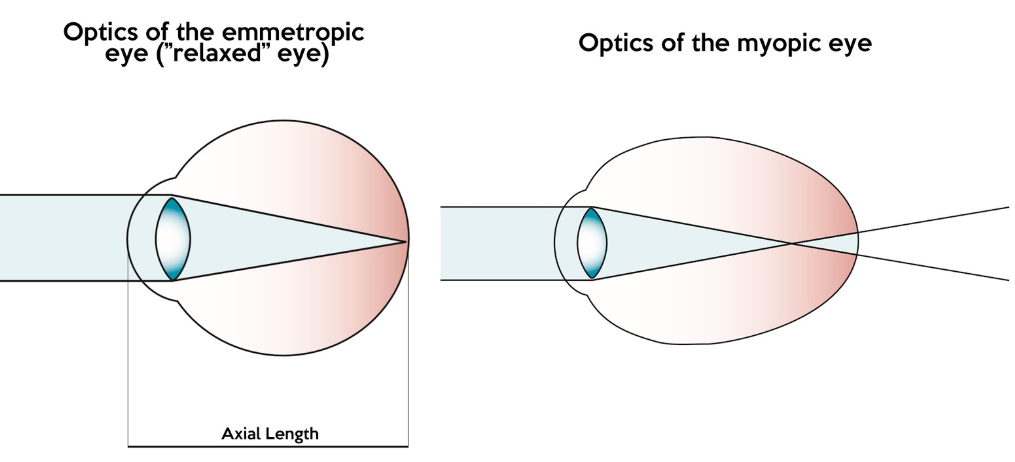Say MY(NO)PIA: Prevent Myopia from developing Into High Myopia

High myopia is a detrimental effect of uncorrected myopia not many know about. Getting glasses is an easy and simple solution for vision correction but those who leave myopia undiagnosed will most likely develop a highly myopic eyesight, which can cause glaucoma and blindness. Read on to find out how you can prevent myopia from developing into high myopia.
Defining Myopia and High Myopia
The elongation of the eye causes Myopia, also known as nearsightedness. The average axial length of an eye is around 23.3mm. The perfect vision has a value of 20/20. If the value is not 20/20, there will be a difference in axial length. This leads to a difference in the refractive error. Refractive error means that the light does not bend properly when it passes through the lens of the eye. Myopia results in a refractive error, whereas for high myopia, it results in an extremely high refractive error.
High myopia (also known as pathological myopia) can be associated with genetics, other conditions (e.g, Marfan syndrome), or early onset myopia which is apparent during middle childhood years. Continuous development of high myopia leads to irreversible visual impairment.
What is the current myopia situation?
What’s worrying is the prevalence of myopia in East Asian countries. It affects 10 to 20% of those stepping out of secondary schools. Specifically in urban centres like Singapore, around 80% of children completing high schools are myopic and 10 to 20% might have high myopia. This can be highly attributed to desk-bound lifestyles of children who do not spend enough time outdoors. So what can we do to prevent the onset of myopia in the first place?
There are many methods to correct vision which include glasses, contact lenses and refractive surgery. Spectacles are widely used and recommended to reduce the progression of myopia in children. However, parents outlined several misconceptions parents regarding vision care.
“My child does not have myopia, hence I have nothing to worry about.”
Having perfect eyesight does not mean that there is no chance of developing myopia in the future. It is important to ensure that your child sustains good eye care habits. This is to prevent myopia from developing in the time to come.
Moreover, it’s also important to get your child’s eyes checked annually even if your child possesses perfect eyesight. Symptoms of vision problems such as myopia at the beginning stage may not hurt but if left undiagnosed, it can lead to more serious effects, like high myopia.
“My child has myopia, but the prescription for glasses is pretty low. So they don’t have to wear them.”
Many parents have a misconception that not wearing low-prescription spectacles can train your child’s eyes and correct their vision. Unfortunately, not wearing glasses could worsen the onset of myopia.
The World Health Organisation (WHO) states that uncorrected myopia is a major cause of blindness. Even when myopia is at low levels, it is pivotal to go for eye examinations regularly and adopt good eye care habits to prevent it from advancing.
How can we treat myopia?
1. Regular eye check ups are key to good eye health
Going for comprehensive eye checks regularly is important regardless of whether your child wears spectacles.
If you are looking to get your child’s eyes checked, book an appointment at your nearest optometry clinic using plano Eyecheck. plano Eyecheck has partnered with Nanyang Optical, W Optics, Videre Eyecare and Optic Point to bring eye exams closer to you at an affordable price. For a limited time, all appointments made using the plano Eyecheck platform will receive a S$50 voucher to cover the cost of the eye check-up. Simply visit planoeyecheck.com and select your nearest optometry clinic the on-site map to book for an appointment.
2. Encourage your child to take breaks when doing near-work activities
Going outdoors to take a walk serves as a great way for your child’s eye to take a break from being glued to their work or phone screens. Increased exposure to light can increase the release of retinal transmitter dopamine (yes, the same chemical that is released when we are happy!), reducing the progression of myopia.
Adopting these habits on a regular basis can help to slow down the progression of myopia and reduce the risk of developing high myopia.
Say MY(NO)PIA.
Tools Designed for Healthier Eyes
Explore our specifically designed products and services backed by eye health professionals to help keep your children safe online and their eyes healthy.

